The Role of Industrial Density in the Health and Economic Consequences of the COVID-19 Crisis

DOI reference: 10.1080/13673882.2021.00001109
By Enrico Vanino, Department of Economics at the University of Sheffield, UK
This article has been funded by Small Grant Scheme on Pandemics, Cities, Regions & Industry: The Role of Industrial Density in the Health and Economic Consequences of the COVID-19 Crisis of the Regional Studies Association (RSA).
One of the most striking features of the COVID-19 pandemic is the marked spatial difference in the spread of the virus. Initially, urban areas were hit hardest by Covid-19, with the spread then shifting to smaller cities, rural towns, and small hamlets. Several studies have investigated this issue, identifying differences in population density and occupational concentrations as some of the key factors explaining the urban-rural difference in the spread of the virus. We should therefore also see these factors as being important in how the virus spreads within a city, where spatial differences are apparent. For example, neighbourhoods with high levels of deprivation have experienced high infection rates relative to low-deprivation neighbourhoods. These differences could also be driven by differences in population density and occupational exposure.
Understanding the contribution of the local economy structure to the diffusion of the pandemic is becoming increasingly important as COVID becomes endemic in the society, with the need for targeted public health measures to address highly localised outbreaks linked to different types of social interaction. However, this requires disentangling the importance of many different factors. For example, neighbourhood density, or occupational composition is likely to be correlated with the crowding of houses. Further, when looking at occupational composition, we want to distinguish between where workers live and where they work to understand how occupation and transmission are related. To achieve these objectives, granular analysis is needed to capture the highly localised dynamics in the diffusion of COVID-19, as this may lead to significant variation in contagion even within the same urban areas.
Our research, funded by the RSA small grant scheme on Pandemics, Cities, Regions & Industry, combines highly granular data for 7200 neighbourhoods across England for the period between March 2020 and April 2021 to quantify the importance of population density versus employment composition on the spread of COVID-19. Specifically, within each neighbourhood, we look at the concentration of key workers, critical or essential workers who are considered to provide an essential service that cannot be done remotely from home, and thus would have continued working onsite even during periods when lockdown restrictions were in place. We use a few different measures of population density, including satellite imagery data to distinguish between daytime and night-time populations. These data are analysed using econometric techniques that allow us to assess the importance of these factors in explaining why COVID-19 spread differently in some neighbourhoods within a city than others while controlling for many other alternative explanations. Our analysis provides several important insights.
First, both higher population density and higher onsite employment density lead to a greater spread of the virus. Neighbourhoods with a high concentration of residents in keyworker jobs have a higher incidence of COVID-19. This result holds whether we look at reported positive cases of COVID-19 or deaths attributed to COVID-19. However, we find that the concentration of keyworkers who work in a neighbourhood is much less important. This finding is consistent with onsite employment during the pandemic facilitating the spread of the virus through workers contracting and bringing the virus home, but not spreading the virus within the neighbourhood in which they are working.
Second, we find that population density and onsite employment density are of similar importance, except in the most deprived neighbourhoods. In these neighbourhoods, the impact of a high concentration of keyworkers leads to a significantly larger prevalence of COVID-19 compared to otherwise similar less deprived neighbourhoods. We do not find this same effect for population density, for which the effect is similar across neighbourhood deprivation levels. It is possible that lower-income, more severe health deprivation, and greater crowding in housing facilitate the spread of the virus carried into the local community by keyworkers, who kept working onsite during the pandemic also to avoid the loss of income. We can get a sense of these results by considering the city of Sheffield, in Figure 1, where there are stark differences in the distribution of population and keyworker density. Keyworkers are highly concentrated in neighbourhoods on the east side of the city, which are also neighbourhoods characterised by higher levels of economic deprivation and a higher incidence of COVID-19. This result holds nationwide as shown in Figure 2, as the relationship between keyworkers density and COVID-19 cases is exacerbated in the most deprived neighbourhoods across the country and by crowded housing conditions.
Figure 1: Distribution of night-time population density, keyworker employment density and COVID-19 deaths per capita across neighbourhoods in the Sheffield Local Authority District.
Night-time population density
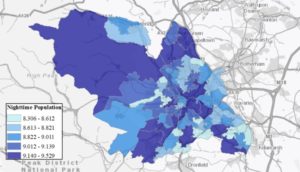
Keyworker employment density
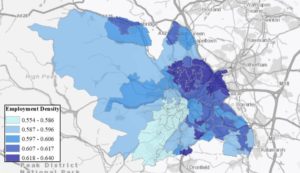
COVID-19 deaths per capita
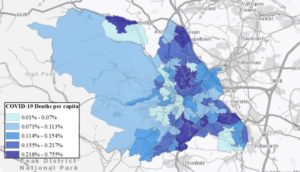
Third, population density and onsite employment density are found to lead to a higher prevalence of COVID-19 only during lockdown periods. When the UK enjoyed a reopening of the economy, between July and November of 2020, the importance of these two factors disappears. This provides interesting evidence on how lockdowns affected the spread of COVID-19. While we observe high levels of infection across neighbourhoods during lockdown periods irrespectively of deprivation, higher levels of population and keyworkers density facilitate the spread of the virus only in the most deprived areas when stricter public health measures limiting social interactions are not in place. This could be due to differences in social interactions between keyworkers and the rest of the population across neighbourhoods with different levels of income. In addition, it could also be explained by the different types of jobs done by keyworkers living in more and less affluent areas, and how they are exposed to interactions with the public.
Readers can interact with our research through an interactive mapping tool available on the project website, which helps to visualise the dynamic evolution of COVID-19 as well as the spatial correlation with population, employment density, and other socio-economic metrics.
This research project, using granular data and novel data sources, allows us to further our understanding of what factors are important in the contagion of COVID-19, and how effective are public health policies at slowing this contagion. A better understanding of the role of density is critical for public health policies directed at mitigating the diffusion of COVID. A more nuanced comprehension of where and how contagion takes place, whether at home or at the place of work and in the latter case through which type of jobs, will be increasingly important in order to help us develop more resilient ‘post-virus’ cities.
Figure 2: Relationship between population and keyworkers density and COVID-19 cases across the deprivation and house crowding distribution.
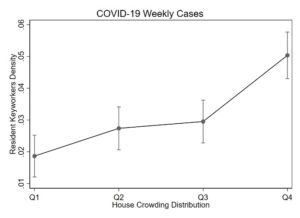
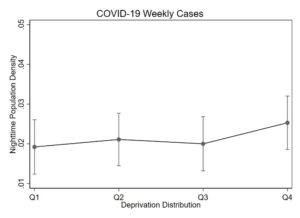
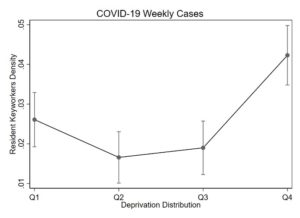
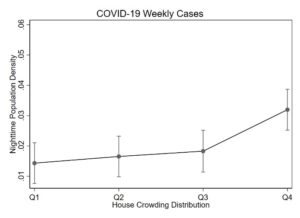
About the author
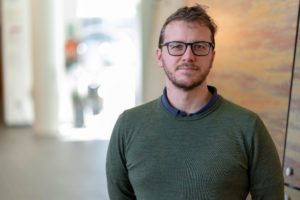
Dr Enrico Vanino is a Lecturer (Assistant Professor) in the Department of Economics at the University of Sheffield. He works on issues related to international economics, urban and regional economics, firms’ productivity, and the economics of innovation. He holds a PhD in economics from the University of Birmingham, and prior to joining the University of Sheffield, he worked as a Fellow in Economic Geography at the London School of Economics. E-mail | @EnricoVanino | Website